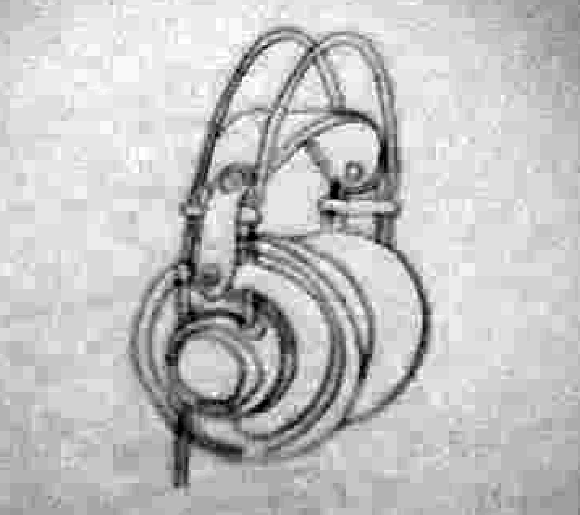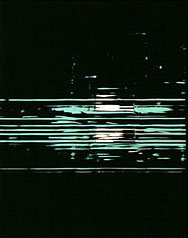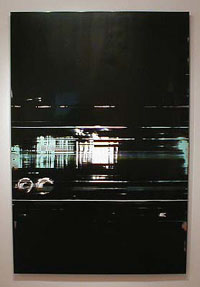View current page
...more recent posts

Headphone drawing by Marisa Olson - my remix.
The following exchange appeared in Houston's online magazine GlassTire back in 2001:
Tire Iron #6 3/15/2001
Inman Gallery
by Bill Davenport
I confess: I myself show at Inman Gallery, so if you feel that this invalidates my opinion of other work shown there, you can stop reading now.
John Pomara's glossy enameled panels are competent, affectless, impersonal. In the past I have used the phrase "toxic pond sludge" (I meant that in a good way) to describe Pomara's abstractions, but these new works at Inman gallery are cleaner. The panels are either black or white; the black ones suggesting nighttime landscapes, time-lapse photographs of headlights on a rain-slick city street. The proportions of the white panels suggest sheets of milky paper, squeegeed into horizontal zips like writing.
In both cases, the vertical orientation of the panel counteracts the horizontal stretch of the painting. Compare these works to Barnet Newman's: if Newman's vertical zips are the figure reduced to its essential gravity-defying assertion of existence, Pomara's horizontal streaks are the equivalent distillation of landscape, stretching flat and sliding sideways at high speed.

John Pomara, Pipeline, 2000
oil enamel on aluminum, 30 x 24 inches
Although they are emphatically about the glossy deliciousness of industrial paint, Pomara's works don't feel like paintings. Their exposed edges show that each is a thin sheet of aluminum laminated to birch plywood. The panels seem manufactured, not painted: the result of the impersonal operation of chance and technique.
The odd, syncopated hanging of the show does a lot for the work; irregular intervals between the panels make them into a sort of Morse code: intermittent, static-laden signals on the information superhighway. In the entranceway, a large black panel is hung next to a similar small one, upsetting one's expectations of typical gallery-style installation. The two panels have an odd relationship: a large and small version of the same thing, or possibly one close-up and one far away.
A discussion of Pomara's work is incomplete without referencing the very similar works of Houston artist Tad Griffin, Pomara's former student. Their co-existence is an opportunity to make subtle comparisons that highlight nuances of both artists' works, which are usually submerged. Here we are comparing, not pears and oranges, but Bosc vs. Bartlett. Both Griffin and Pomara swipe intermittent stripes of black and white paint across aluminum panels. Pomara's recent works are more pictorial: his streaks condense at the middle of the panel to imply depth, demarcating foreground, middle, and background; Griffin's all-over patterns are a depthless skin stretched across the surface of his paintings. Griffin's intervals are regular, but not mechanical; he is a man imitating a machine. Pomara's irregular compositions of stripes and gaps are the opposite: a painter using mechanical techniques to depersonalize his pictures. If we can collect one or two more Texas squeegee painters we'd have a school!
Response to Tire Iron #6 3/15/2001 [Update: this comment has gone missing from Glasstire but I saved it here]
Bill Davenport makes some good points about John Pomara's work. I have a couple of quibbles, and a thing or two to add. First, when I read that something is "competent, affectless, and impersonal," my first question is, why? I wish Davenport had gone more into the reasons a painter might deliberately work that way. My own theory is that many painters are still drawn to "the gesture," an unplanned, frequently exhilirating way of generating visual information, but are sick of the romantic action-painter myth left over from the '50s. The use of squeegees — or in Pomara's case, customized painter's shields — to blur and scrape away paint is a way of literally eradicating the gesture, but also adding another exciting, randomizing variable in the creation of a picture.

John Pomara, On Line, 2000
oil enamel on aluminum, 72 x 48 inches
This new variable suggests fresh content: the "impersonality" and "affectlessness" of the times, yes, but also a reference to the new visual landscape given to us by technology — "intermittent, static-laden signals on the information superhighway," as Davenport nicely puts it. There are plenty of interesting artists working in this territory: Stephen Ellis, John Zinsser, Bill Komoski, Shirley Kaneda, Mark Sheinkman, William Wood, Carl Fudge, Rochelle Feinstein, to name a few. Instead of the somewhat belittling "squeegee school," a better term would be mediated abstraction, referring to media in both the material and communications sense. This is an international tendency among painters, which both Pomara and Griffin are aware of and plugged into. And which, I might add, Pomara continues to work and evolve in. If we must compare Pomara and Griffin, a better job could be done. "Griffin is a man imitating a machine," Davenport says, while Pomara is "a painter using mechanical techniques to depersonalize his pictures." Isn't that a distinction without a difference? I'd say Pomara, with his succulent surfaces and all-too-human imperfections, is a man imitating a machine, while Griffin, with his high-polished control of every millimeter of a picture, is more like a machine imitating a man. (And I mean that in a good way.) - Tom Moody, New York
My reply has been edited slightly for punctuation and syntax. Some newer work by Pomara is referenced here. Earlier posts on him are here and here. With five and a half years' hindsight, I'd say that almost none of the painters mentioned in my reply represents much of a viable school any longer, except Pomara, who is busy morphing it into something else. Those *were* artists imitating machines, or a machine look, and little besides--that was probably not a good phrase to apply to him, because he's actually thinking below the surface of the computer, using processes of creative decomposition with imaging software to develop a new "pixelesque" iconography. His work belongs in the new media dialogue--painting is just a part of it.
